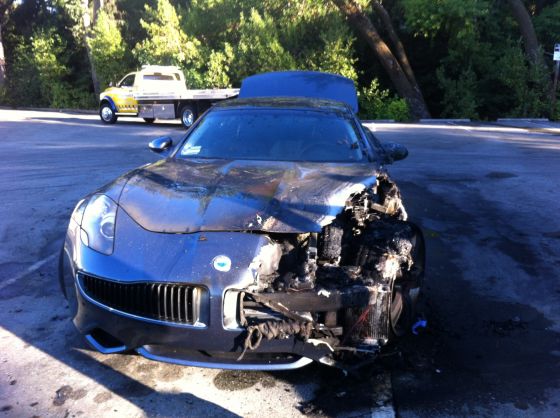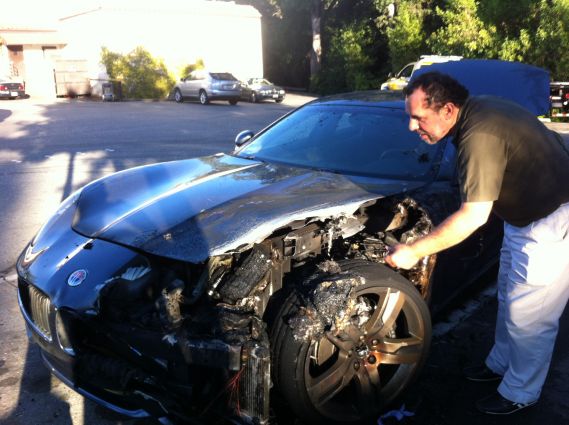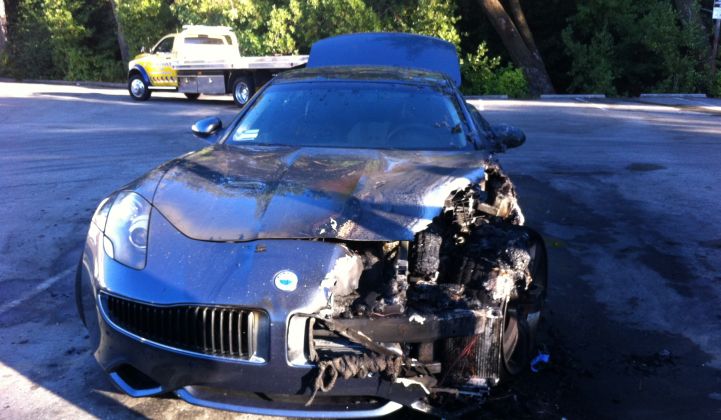Last week we were eyewitness to a Fisker Karma extended range electric vehicle in flames in a parking lot in Woodside, California (see pictures below).
I had spied the smoldering carcass of a Fisker Karma in the Roberts Market parking lot and spoke with the owner of this particular Fisker, Rudy Burger, a managing partner at Woodside Capital Partners. He said that the car was smoking when he pulled it into the parking lot, where the fire proceeded to melt the front left side of the vehicle body.
Burger was unscathed and remains undeterred. In a statement from the billion-dollar automotive startup, Burger was quoted as saying, “I have been incredibly impressed with the way Fisker has handled this incident. I have personally started seven technology companies and know from direct experience that the U.S. needs more innovative companies of this type, especially in the automobile sector. Fisker is a great company and one that I am personally planning to invest in. I look forward to getting behind the wheel of my next Fisker.”
A VC colleague once told me that if venture capitalists had tolerance for risk, they'd be entrepreneurs. But Burger remains willing to step into another Fisker. Good for him.
Also in the statement from the firm was information on the root cause of the fire: "The investigation located the ignition source to the left front of the Karma, forward of the wheel, where the low temperature cooling fan is located. The final conclusion was that this sealed component had an internal fault that caused it to fail, overheat and start a slow-burning fire."
Fisker is conducting a recall of the Karma "to have the cooling fan replaced with a unit that meets the required specifications. At the same time, an additional fuse will be installed for added protection." The statement continues, adding, "In their investigation, independent experts established that the incident was not caused by the lithium-ion battery pack, new technology components, engine component packaging or unique exhaust routing of the Fisker Karma."
In May of this year, a Fisker set fire to an owner's garage in Texas.
We get it. Automotive recalls happen all the time. Suzuki just recalled nearly 102,000 Reno and Forenza models "due to an electrical wiring problem, which may lead to headlamp failure."
It's just that the optics of this type of incident are absolutely terrible for Fisker. The firm is also the recipient of a DOE loan (see Solyndra, Abound Solar, Beacon Power, etc.) and has received funding from the Qatar Investment Authority. Fisker is also tied to the struggling and recently rescued battery maker A123.
Fisker recently crossed the $1 billion mark in investment and is reportedly on the hunt for $150 million more in funding with the help of Advanced Equities, according to DowJones VentureWire.
While vehicles are being recalled, so is corporate leadership.
In March of this year, Fisker co-founder Henrik Fisker was moved to the role of Executive Chairman of the firm, while Tom LaSorda was appointed as CEO and Vice Chairman of the Board. LaSorda was formerly CEO, President and Vice Chairman of the Chrysler Group and has also held executive positions at General Motors.
This week the firm named Tony Posawatz, "the former head of the Volt program at General Motors," as its new CEO, according to a release. LaSorda will remain as "an advisor."
Elon Musk, CEO of electric vehicle vendor Tesla, interviewed in Automobile magazine, had a few choice comments on the Fisker:
"I don't think very highly of Henrik Fisker. [...] The fundamental problem with Henrik Fisker he is a designer or stylist. [...H]e thinks the reason we don't have electric cars is for lack of styling. This is not the reason. It's fundamentally a technology problem. At the same time, you need to make it look good and feel good, because otherwise you're going to have an impaired product. But just making something look like an electric car does not make it an electric car. [Fisker] thinks the most important thing in the world -- or the only important thing in the world -- is design, so he outsourced the engineering and manufacturing. But the fact is, [...] that's the crux of the problem. And he's outsourcing to people who don't know how to solve the problem. So he came up with a product -- it's a mediocre product at a high price. It looks good. Particularly from the side it looks good. I don't love the front. It looks too much like a caricature of a Mexican Bandito, the grille. The car looks very big, it's bigger than the Model S, but it has no trunk space and it's cramped inside, particularly in the rear seats. The mark of a good design is something that has great aesthetics and great functionality."
Musk has his own set of automobile manufacturing challenges ahead of him. He has to build 30,000 Model S Sedans in the next six quarters.





